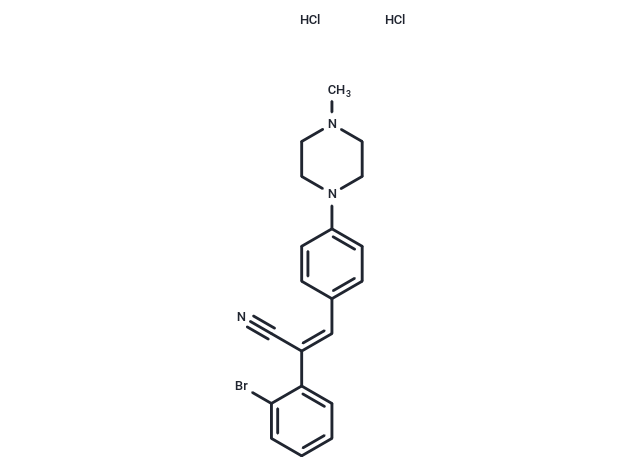Shopping Cart
- Remove All
 Your shopping cart is currently empty
Your shopping cart is currently empty

DG172 dihydrochloride (DG-172 dihydrochloride) is an antagonist of PPARβ/δ(IC50 : 27 nM).

| Pack Size | Price | Availability | Quantity |
|---|---|---|---|
| 2 mg | $34 | In Stock | |
| 5 mg | $55 | In Stock | |
| 10 mg | $97 | In Stock | |
| 25 mg | $197 | In Stock | |
| 50 mg | $322 | In Stock | |
| 100 mg | $522 | In Stock |
| Description | DG172 dihydrochloride (DG-172 dihydrochloride) is an antagonist of PPARβ/δ(IC50 : 27 nM). |
| Targets&IC50 | PPARβ/δ:27 nM |
| In vitro | DG172 is a novel PPARβ/δ-selective ligand showing high binding affinity (IC(50) = 27 nM) and potent inverse agonistic properties.?DG172 selectively inhibited the agonist-induced activity of PPARβ/δ, enhanced transcriptional corepressor recruitment, and down-regulated transcription of the PPARβ/δ target gene Angptl4 in mouse myoblasts (IC(50) = 9.5 nM).?Importantly, DG172 was bioavailable after oral application to mice with peak plasma levels in the concentration range of its maximal inhibitory potency, suggesting that 37 will be an invaluable tool to elucidate the functions and therapeutic potential of PPARβ/δ[1]. |
| Alias | DG-172 dihydrochloride, DG172 (dihydrochloride) |
| Molecular Weight | 455.2 |
| Formula | C20H22BrCl2N3 |
| Cas No. | 1361504-77-9 |
| Smiles | Cl.Cl.CN1CCN(CC1)c1ccc(\C=C(/C#N)c2ccccc2Br)cc1 |
| Relative Density. | no data available |
| Storage | Powder: -20°C for 3 years | In solvent: -80°C for 1 year | Shipping with blue ice. | |||||||||||||||||||||||||
| Solubility Information | H2O: 14.29 mg/mL (31.39 mM), Sonication is recommended. | |||||||||||||||||||||||||
Solution Preparation Table | ||||||||||||||||||||||||||
H2O
| ||||||||||||||||||||||||||

Copyright © 2015-2025 TargetMol Chemicals Inc. All Rights Reserved.